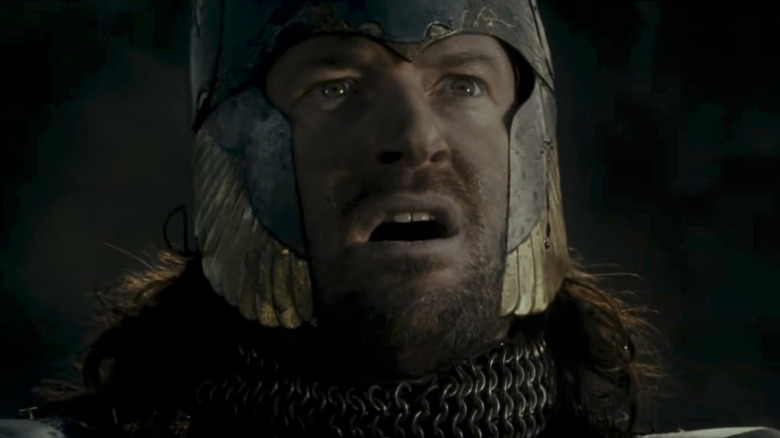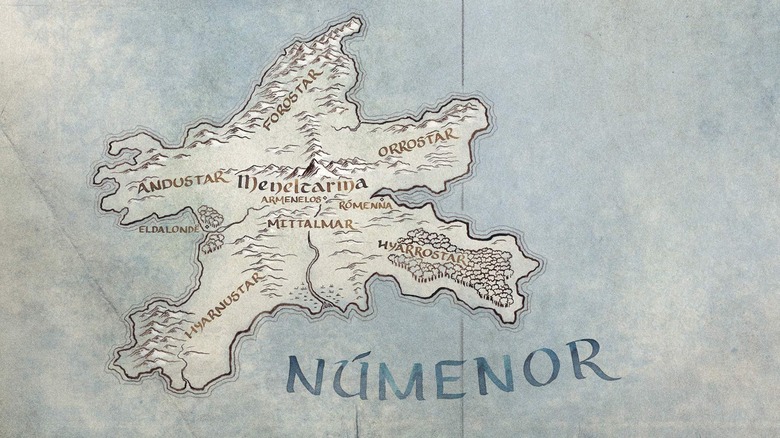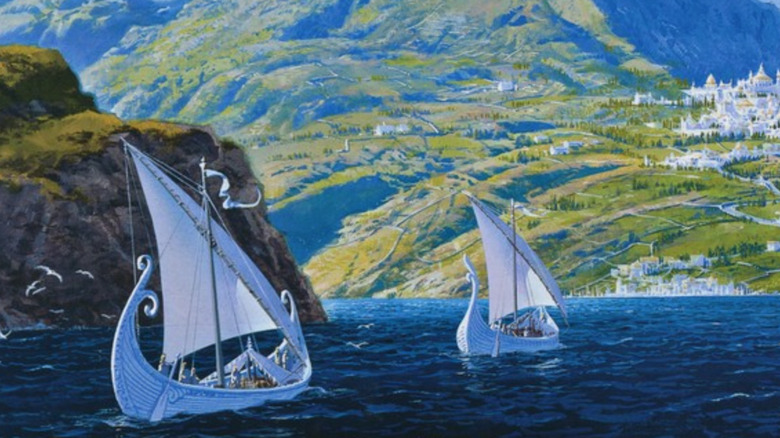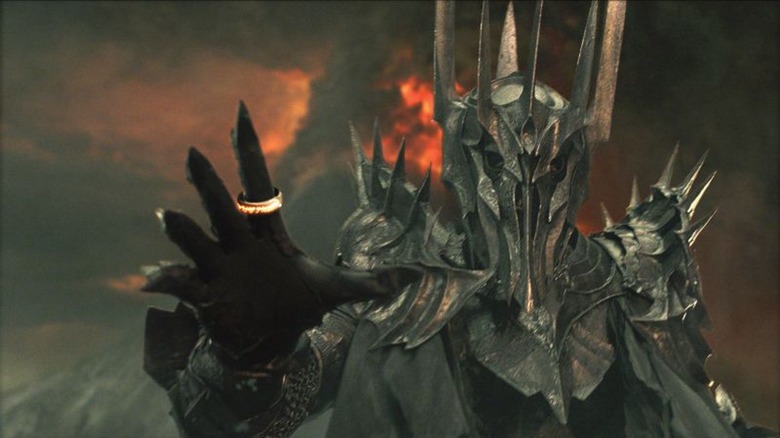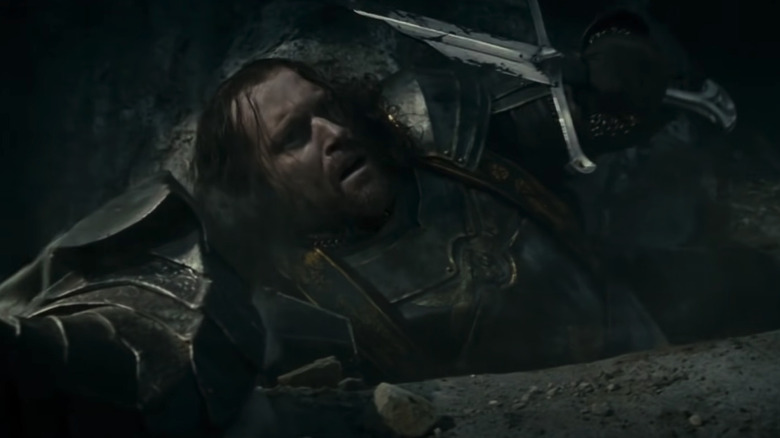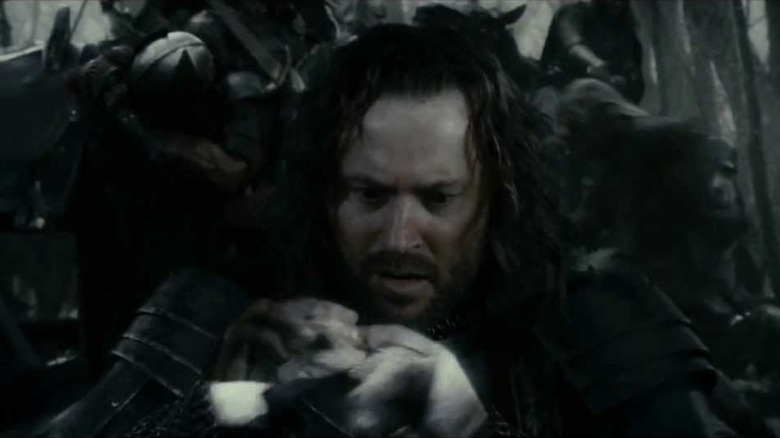The Lord Of The Rings: Isildur's Entire Backstory Explained
"The Lord of the Rings" has an abundance of heroes scattered throughout its long narrative. While many of these are from the Third Age, there are points in the trilogy of books when earlier times and previous icons are referenced. One of these is Isildur. The great king of men is briefly depicted in Peter Jackson's "The Fellowship of the Ring," when he cuts the One Ring off of Sauron's hand during the film's prologue. From there, he moodily turns down Elrond's advice to destroy it, and then is killed in an ambush, losing the mighty trinket in the River Anduin.
By and large, most of Isildur's screen time is pretty unflattering. Sure, he stops Sauron dead in his tracks, but after that, the guy just can't seem to get things right. This gives the impression that Isildur is a "one-hit wonder" kind of a hero — the kind of character that does one thing right, and is otherwise kind of a nasty dude. When you break it down, though, it turns out that Isildur is a far cry from a bad guy. On the contrary, if you dig into Tolkien's original source material, Isildur is actually a bona fide hero who just happens to make a couple of bad, Ring-influenced decisions at the end of his life.
Isildur also happens to live the bulk of his life during the Second Age — that is, three-thousand years before "The Lord of the Rings" takes place. This is the time period that Amazon has chosen for its gigantic Middle-Earth project, which means there's a good chance we'll get more onscreen Isildur action beyond Sir Jackson's little teaser. With that in mind, we've pulled together a brief rundown of the hero's life, which goes much further back than his brief end-of-life stint with the One Ring. Isildur's story starts in one of the most incredible places in all of Middle-Earth history: the island of Númenor.
Life in Númenor
Isildur is born in Númenor a couple of hundred years before the end of the Second Age. He's the son of Elendil, and related to the king of the land. This is important, as the royal family of the island nation is gifted with extraordinary life (a trait that carries forward in Isildur's many-times-great grandson Aragorn). For those of you counting at home, this makes Isildur around 250 years old when he fights Sauron and claims the One Ring for himself. Looks pretty good, doesn't he?
The Númenóreans dominate Middle-earth politics during Isildur's lifetime. At one point, Númenor even tussles with Sauron and utterly cows the Dark Lord into submission. When that happens, the king of Númenor, Ar-Pharazôn, takes Sauron captive and brings him back to his island where the villain immediately starts corrupting his captors. Over the next few years, Sauron goes from ruin to riches, becoming the king's right-hand man — and that's where the young Isildur first comes into the bigger story.
After Sauron becomes the king's advisor, he begins influencing the entire nation with his evil agenda. As Sauron's power grows, he orders the white tree Nimloth to be cut down. The tree is an ancient gift of the Elves and the angelic Valar, who live in the immortal Blessed Realm far in the west of Middle-earth. In fact, it's that tree's dead descendant that can be seen in the courtyard of Minas Tirith during "The Lord of the Rings." Before Sauron's nefarious deed can be carried out, though, who should appear on the scene but Isildur. The youthful royal family member disguises himself and sneaks into the court of the king where he steals a single fruit from the doomed arboreal wonder. Isildur is seriously wounded as he fights through the guards, but he escapes and keeps the fruit safe, even while the tree is cut down and burned.
The flight of the Faithful
Isildur is a member of a political faction of Númenóreans known as the Faithful or the "Elf-friends." This already-marginalized group comes under intense persecution as Sauron's power in Númenor waxes. As the pressure mounts, Isildur and his father Elendil and brother Anárion prepare a small fleet of nine ships. Eventually, Sauron convinces the king to attack the immortal lands in the West, and the king sails off with his entire military. Of course, the puny mortal men are no match for the god-like Valar and the immortal Elves, and they are swallowed up by the sea when they arrive. In fact, the entire island of Númenor goes down with them ... everything except nine ships crewed by the Faithful and led by Elendil and his sons.
The group barely escapes the Atlantis-like catastrophe, and their little fleet is scattered in the process. "The Silmarillion" explains in epic fashion: "They fled before the black gale out of the twilight of doom into the darkness of the world." It goes on to detail that mountainous waves literally lift the ships into the wreckage of the clouds, and after many days, they are "cast ... upon the shores of Middle-earth." When that happens, dad finds himself up in the north of the continent. There are already some Númenórean settlements in the area, and he decides to found the nation of Arnor.
The ships of Isildur and his brother end up landing far in the south, where they establish the nation of Gondor. The brothers become co-rulers and begin busily building up cities, towers, fortresses, and other impressive construction projects. Of particular note, Anárion lives in Minas Anor (later known as Minas Tirith) while Isildur chooses Minas Ithil as his home. This is the same city that is later captured by the Ringwraiths, and becomes their ghastly home base.
The return of Sauron
For a while, everything seems hunky-dory for the Númenórean survivors. Isildur keeps the sapling of the White Tree in Minas Ithil, and he and his brother and father busily tend to their new domains. However, they leave one critical person out of their calculations: Sauron. Of course, this is a pretty natural thing to do. After all, the Dark Lord literally went down in a blaze of destructive glory along with the rest of Númenor.
But it turns out that, while his corporeal body is lost, Sauron's spirit returns to Middle-earth and takes a new form. His original body had been attractive by all accounts, but "The Silmarillion" tells us that his rebooted body is "terrible, for his fair semblance had departed for ever when he was cast into the abyss at the drowning of Númenor." Once he's in this more intimidating body, Sauron wastes no time stirring up trouble for his unwanted new neighbors. Gondor is particularly close to his fortress region of Mordor, with Isildur's city of Minas Ithil right on his doorstep. For this reason, when Sauron unleashes hell on the Númenórean exiles, it's Isildur that gets the first wave of aggression right in the kisser. "The Silmarillion" explains that Sauron "came with great force against the new realm of Gondor, and he took Minas Ithil and he destroyed the White Tree of Isildur that grew there."
While Sauron is busy devastating another White Tree, though, Isildur manages to stay one step ahead. The hero escapes from the destruction with yet another seedling, at which point he heads off to join his brother. Together, they are able to hold Sauron's armies off for a while, but it's clear that they'll need help if their new kingdom is going to survive. It's at this point that their dad — along with a whole lot of other folks — comes to their rescue.
The Last Alliance of Elves and Men
Seeing the overpowering host of Sauron amassed, Isildur's dad, Elendil, joins forces with the Elven King Gil-galad and many others, including Elrond, to form the Last Alliance. This group is primarily made up of men and Elves, but "The Silmarillion" also says that the Dwarves of Khazad-dûm as well as many birds and beasts fought with them, as well. Also in the host is Isildur, along with three of his sons. His wife and fourth infant son are sent to Rivendell.
Once gathered, the host of the Last Alliance attacks Mordor. The fighting starts north of Mordor in the area that eventually becomes the Dead Marshes. In fact, the soldiers that die in the fighting are represented in the ghastly creatures that haunt the murky pools when Frodo, Sam, and Gollum cross the swampy territory during "The Two Towers."
The fighting drags on for seven long years — yes, that's years — but the good guys slowly force their way into Mordor proper. Once in the corrupted land, they besiege Sauron's tower of Barad-dûr. Isildur's brother is killed during the siege, but they finally get to the point where Sauron is so desperate that he, himself, comes out to fight. This is the scene that we're all used to seeing at the beginning of "The Fellowship of the Ring" film.
The Dark Lord is confronted by the various heroes that are facing him. Elendil, Gil-galad, Isildur, Elrond, and others attack the superhuman being, and both Elendil and Gil-galad are killed. Sauron even breaks Elendil's sword, Narsil, but Isildur uses the shards to desperately slash the One Ring off of his enemy's hand. This takes down Sauron (at least temporarily) and ends the war in an instant — but it also is the beginning of the end for our intrepid Númenórean monarch.
Taken down by the Ring
When Isildur defeats Sauron, the Dark Lord's Ring of Power falls into his hands. In "The Fellowship of the Ring," Elrond, one of the few witnesses of the event, explains that "It should have been cast then into [Mount Doom's] fire night at hand where it was made ... But Isildur would not listen to our counsel."
After the war, Isildur becomes the High King of both Gondor and Arnor. He stays in Gondor for a while and even writes about his experiences. This is how Gandalf finds Isildur's scroll where he explains what the Ring was like after he won it in battle. After a while, the High King heads north where his wife and youngest son are still safely tucked away in Rivendell. And it's here, of course, that he's taken by surprise and killed.
However, the event of Isildur's death is quite a bit different from the cinematic adaptation. In Tolkien's writings, particularly his posthumous book "Unfinished Tales," he explains how Isildur and his three sons and 200 mighty bodyguards were jumped by a large group of Orcs. The soldiers are slowly ground down under relentless fighting until Isildur tries to escape wearing the One Ring. The Ring, which is guiding events at this point, slips off of his finger when he is crossing the Great River, and Isildur finally meets his doom via the business end of an Orc arrow.
Isildur's surviving son carries on the family tree — all the way to Aragorn — and the king's squire, Ohtar, escapes with the shards of his father's sword. But for Isildur, this is the end of the line. Interestingly, in "The Fellowship of the Ring," Elrond feels it necessary to point out that, while he dies, "Yet death maybe was better than what else might have befallen him." A nod to the corrupting power of the One Ring? Why yes, yes indeed.
